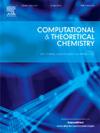范德华MoSeTe/GaSe异质结构的电子和光催化特性
IF 3
3区 化学
Q3 CHEMISTRY, PHYSICAL
引用次数: 0
摘要
寻找一种高效的光催化剂对于解决能源短缺和环境污染问题至关重要。二维(2D)材料由于其显著的电子、光学和机械特性而引起了相当大的兴趣。它们被认为是硅基半导体的潜在替代品。二维材料作为高效光催化的有效候选材料显示出巨大的潜力。这是由于它们异常高的表面积和电荷载流子必须穿越的最小距离。镓单硫族化合物(GaX,其中X = S, Se, Te)和Janus过渡金属二硫族化合物由两种不同的硫族化合物(S, Se或Te)与单一过渡金属(Mo, W, Pt等)配对组成,它们在光催化水分解方面的潜力越来越得到认可。这种认识是由于它们具有良好的带隙和显著的稳定性。在本研究中,我们基于第一性原理计算研究了一种新型范德华MoSeTe/GaSe异质结构的电子能带结构、光催化性能和稳定性。由于内置电场的作用,MoSeTe/GaSe异质结构显示出作为整体水分解光催化剂的潜力。界面处的内置电场有效地分离了光生载流子。我们的研究结果表明,能量稳定的MoSeTe/GaSe异质结构呈现i型波段对准,这促进了光生电子-空穴对的空间约束,这是增强辐射复合的有利特征,使其适合光电应用。值得注意的是,异质结构具有0.881 eV的间接带隙。晶格失配率为0.68%,结合能计算为7.5 meV/原子,表明热力学有利。带边包含了水的氧化还原电位,表明异质结构可以通过光催化分解H2O促进产氢。这项研究导致了一组具有光催化应用潜力的新型材料的发展。本文章由计算机程序翻译,如有差异,请以英文原文为准。

Electronic and photocatalytic characteristics of van der Waals MoSeTe/GaSe Heterostructures
Identifying an efficient photocatalyst is essential for tackling energy scarcity and environmental pollution. Two-dimensional (2D) materials have attracted considerable interest owing to their remarkable electronic, optical, and mechanical characteristics. They are regarded as potential alternatives to Si-based semiconductors. 2D materials exhibit significant potential as effective candidates for highly efficient photocatalysis. This results from their exceptionally high surface area and the minimal distance charge carriers must traverse. Gallium monochalcogenides (GaX where X = S, Se, Te) and Janus transition metal dichalcogenides, which consist of two different chalcogenides (S, Se, or Te) paired with a single transition metal (Mo, W, Pt, etc.), are increasingly recognized for their potential in photocatalytic water splitting. This recognition is attributed to their advantageous band gap and remarkable stability. In this present work, we study the electronic band structure, photocatalytic properties, and stability of a novel van der Waals MoSeTe/GaSe heterostructure based on first-principles calculations. The MoSeTe/GaSe heterostructure demonstrates potential as a photocatalyst for overall water splitting, attributed to the effects of the built-in electric field. The built-in electric field at the interface effectively separates photogenerated carriers. Our results reveal that the energetically stable MoSeTe/GaSe heterostructure exhibits a type-I band alignment, which promotes the spatial confinement of photogenerated electron-hole pairs a favourable feature for enhanced radiative recombination, making it suitable for optoelectronic applications. Notably, the heterostructure possesses an indirect band gap of 0.881 eV. The lattice mismatch rate is 0.68 %, and the binding energy is calculated at 7.5 meV/atom, suggesting thermodynamically favourable. The band edge encompasses the redox potential of water, suggesting that the heterostructure can facilitate hydrogen production through the photocatalytic decomposition of H2O. The research has resulted in the development of a novel group of materials with significant potential for photocatalytic applications.
求助全文
通过发布文献求助,成功后即可免费获取论文全文。
去求助
来源期刊

Computational and Theoretical Chemistry
CHEMISTRY, PHYSICAL-
CiteScore
4.20
自引率
10.70%
发文量
331
审稿时长
31 days
期刊介绍:
Computational and Theoretical Chemistry publishes high quality, original reports of significance in computational and theoretical chemistry including those that deal with problems of structure, properties, energetics, weak interactions, reaction mechanisms, catalysis, and reaction rates involving atoms, molecules, clusters, surfaces, and bulk matter.
 求助内容:
求助内容: 应助结果提醒方式:
应助结果提醒方式:


